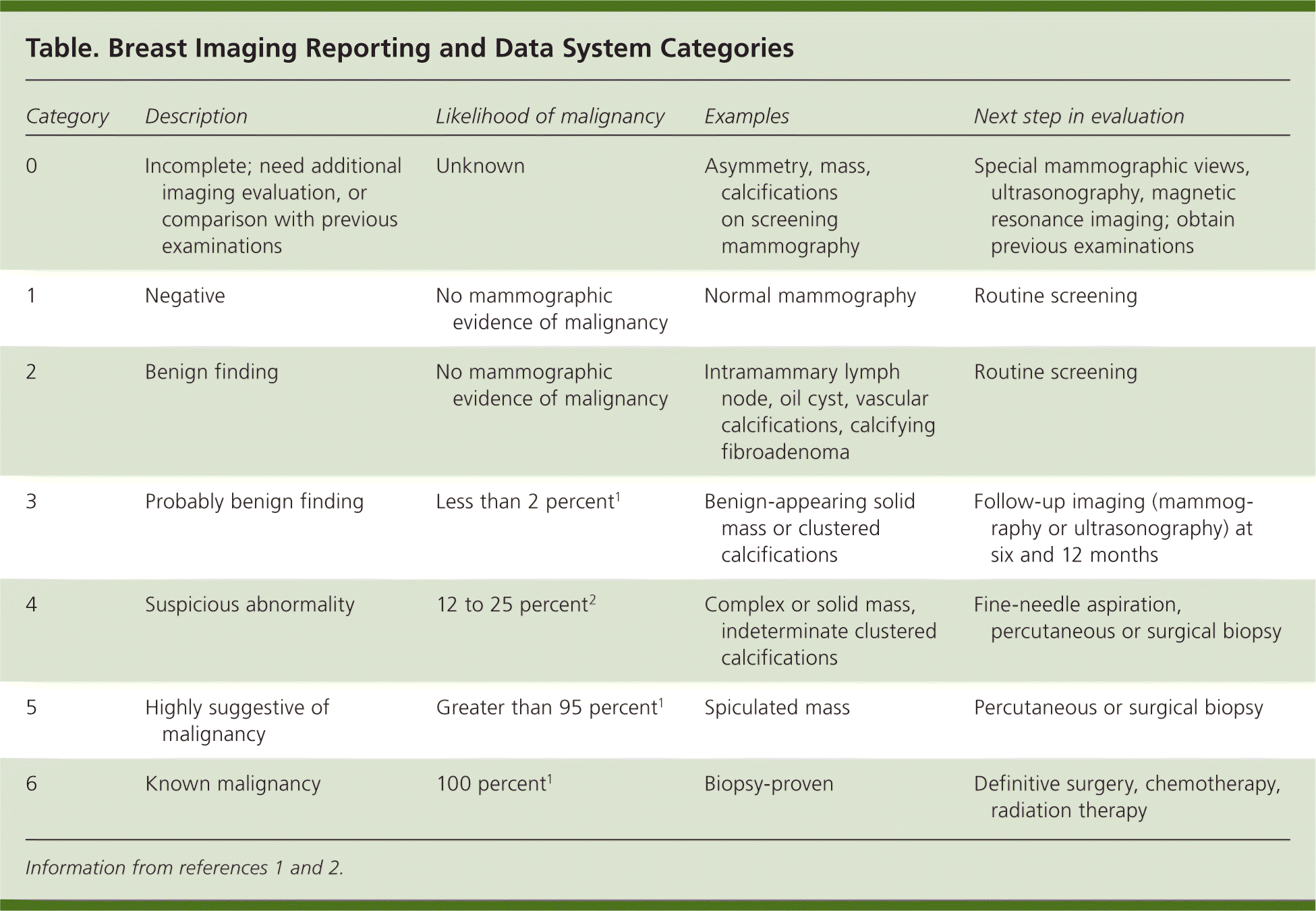
Am Fam Physician. 2010;82(2):114-115
Author disclosure: Nothing to disclose.
Mammography reports use specific terminology from the Breast Imaging Reporting and Data System (BI-RADS)1 to describe findings and to assign a final assessment category (see accompanying table1,2 ). At times, there may be a question about why a particular category has been selected for a certain patient's examination, and what subsequent management is needed. This editorial addresses questions that commonly arise when primary care physicians interpret mammography reports.

| Category | Description | Likelihood of malignancy | Examples | Next step in evaluation |
|---|---|---|---|---|
| 0 | Incomplete; need additional imaging evaluation, or comparison with previous examinations | Unknown | Asymmetry, mass, calcifications on screening mammography | Special mammographic views, ultrasonography, magnetic resonance imaging; obtain previous examinations |
| 1 | Negative | No mammographic evidence of malignancy | Normal mammography | Routine screening |
| 2 | Benign finding | No mammographic evidence of malignancy | Intramammary lymph node, oil cyst, vascular calcifications, calcifying fibroadenoma | Routine screening |
| 3 | Probably benign finding | Less than 2 percent1 | Benign-appearing solid mass or clustered calcifications | Follow-up imaging (mammography or ultrasonography) at six and 12 months |
| 4 | Suspicious abnormality | 12 to 25 percent2 | Complex or solid mass, indeterminate clustered calcifications | Fine-needle aspiration, percutaneous or surgical biopsy |
| 5 | Highly suggestive of malignancy | Greater than 95 percent1 | Spiculated mass | Percutaneous or surgical biopsy |
| 6 | Known malignancy | 100 percent1 | Biopsy-proven | Definitive surgery, chemotherapy, radiation therapy |
The same standard terminology (e.g., mass, asymmetry, calcifications) may be used to describe benign or suspicious findings. A mass, for example, can be benign (with a smooth, well-circumscribed margin) or suspicious (with a spiculated margin) in appearance. As a result, the term “mass” could be included in BI-RADS categories 2 (benign findings) through 6 (known malignancy).
BI-RADS category 0 indicates insufficient imaging information to allow for complete evaluation. One example is an abnormal finding on screening mammography that requires further imaging or comparison with previous mammography to verify stability of the finding. After such additional evaluation or comparison, an amended report with a final assessment category (BI-RADS 1 through 6) will be issued.
Results categorized as BI-RADS 1 or 2 are negative or benign; routine screening mammography is typically recommended. However, there are exceptions. For example, if a patient with a palpable lump has been referred for mammography, the next step, even with negative findings, typically is to refer the patient to a surgeon for consultation. Ultrasonography is an alternative, because some studies have shown that the combination of negative mammography and negative targeted ultrasonography in the setting of a palpable breast abnormality has a low likelihood of malignancy (2.6 to 2.7 percent).3
BI-RADS category 3 lesions are most likely benign (less than 2 percent risk of malignancy 1). Other studies indicate an even lower risk of 0.4 to 0.8 percent.2,4 Short-term follow-up (typically reimaging at six and 12 months) is needed, and lesion growth during surveillance should prompt biopsy. Cancers found during this process have a favorable prognosis.
BI-RADS category 4 and 5 lesions are suspected to be malignant. On mammography, BI-RADS category 5 lesions show classic characteristics for cancer (such as spiculated masses). BI-RADS category 4 includes any other findings for which malignancy cannot be excluded, ranging pathologically from fibrocystic tissue to cancer. Tissue sampling (i.e., fine-needle aspiration, or percutaneous or surgical biopsy) typically is needed to further evaluate these lesions.
BI-RADS category 6 indicates a current, diagnosed breast cancer undergoing further imaging evaluation or biopsy. A patient with a history of already-treated breast cancer would not fall into this category, but would be assessed according to current findings.
Use of the BI-RADS categories on mammography reports provides clear communication of the overall results. Although a number of findings may be described, the key question, “Should I be worried about this patient?”, is settled concisely by looking for the BI-RADS category at the end of the report. The assigned category can be useful to primary care physicians, as it is to radiologists, to ensure that the appropriate follow-up is performed. Because the number of patients with a BI-RADS category indicating a need for further assessment (categories 0, 3, 4, and 5) is relatively small compared with the total number of women in a practice undergoing mammography, the numeric category simplifies follow-up by flagging patients in need of more extensive evaluation.
